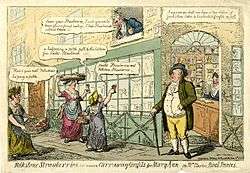Samuel William Fores
Samuel William Fores, often credited as S. W. Fores (1761 – 3 February 1838) was an English illustrator and publisher/printer based in Piccadilly, London.[1] Fores, the son of a cloth merchant, began his career publishing his illustrations in 1783. He operated from premises at No 3 Piccadilly from 1785 and moved to 50 Piccadilly from 1795 [2]. He specialised in caricature, typically hand-coloured, singly issued prints.[3][4] He became successful at marketing his works, which he often sold wholesale.[4] Fores acquired a particularly large collection of caricatures, and at one time was said to have "the completest collection in the kingdom" in his Caricature Museum.[5] He died in February 1838 at the age of 77 and was buried in his family vault at St. James Church in Jermyn Street.[6]


Works
The National Portrait Gallery documents 64 of his works or works he published. As a publisher he published cartoons designed by Gillray and Rowlandson, such as Rowlandson's Comforts of Bath series.[4] One of his depictions was of the March 1791 fire at Albion Mills adjacent to Blackfriars Bridge. In 1793 he was noted for his caricatures of the French Revolution, especially his Complete Model of the Guilllotine, which was reported by some to be as high as six feet. Visitors were charged a shilling to view it.[5]
References
| Wikimedia Commons has media related to Samuel William Fores. |
- A Collection of the Public General Statutes, Passed in the Fifty-ninth Year of the Reign of His Majesty King George the Third: Being the First Session of the Sixth Parliament of the United Kingdom of Great Britain and Ireland. G. Eyre and A. Strahan, printers to the King. 1819. p. 1465.
- Maxted, Ian (1977). The London Book Trades1775-1780. Folkstone, England: Dawson. p. 83. ISBN 0-7129-0696-7.
- "Samuel William Fores". British Museum. Retrieved 9 October 2014.
- "Samuel William Fores". National Portrait Gallery. Retrieved 9 October 2014.
- The Quarterly Review. John Murray. 1866. p. 241.
- Rose, John Holland. Napoleon in Caricature 1795–1821. Рипол Классик. p. 58. ISBN 978-5-87781-473-8.